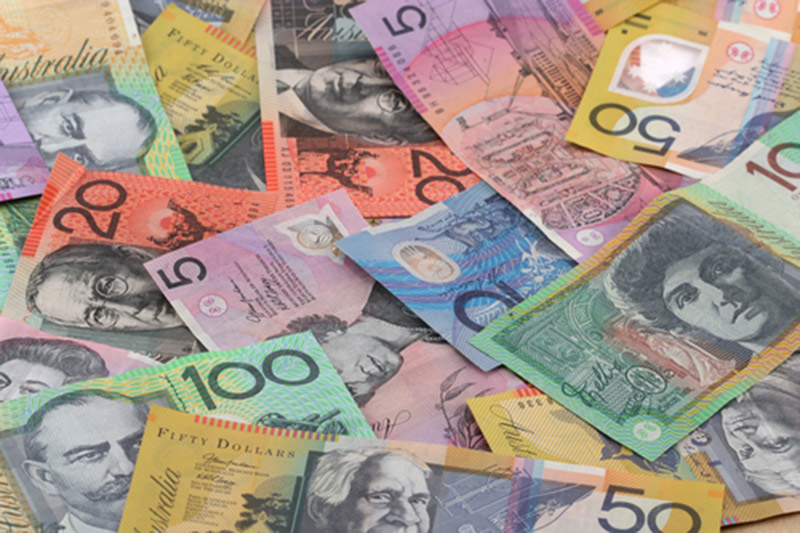Investing.com - The Australian dollar gained on Tuesday as trade data for November showed a much narrower deficit than expected.
AUD/USD traded at 0.8112, up 0.34%, while USD/JPY traded at 119.40, down 0.19%.
Australia's November trade balance came in at a deficit of A$925 million, compared to expectations for a wider deficit of A$1.59 billion.
Then at 0945 Beijing time (0145 GMT), HSBC's China December services PMI is due. In November, the survey showed a reading of 48.8.
Overnight, the dollar remained near nine-year highs against the other major currencies in quiet trade on Monday, as expectations for a U.S. rate hike this year continued to lend broad support to the greenback.
The U.S. dollar index, which measures the greenback against a basket of six major currencies, rose 0.05% to 91.70.
Demand for the dollar continued to be underpinned by the diverging policy outlook between the Federal Reserve and central banks in Europe and Japan.
The Fed is widely expected to raise interest rates in the coming year as the steady economic recovery in the U.S. continues.
EUR/USD hit lows of 1.1858, the weakest since February 2006, and was last at 1.1938, up 0.03% on Tuesday in Asia.
The single currency came under pressure after official data showed that German inflation slowed to the lowest level since 2009 in December.
German consumer price inflation accelerated at an annualized rate of 0.2% last month, below forecasts for 0.3% and slowing from 0.6% in November.
The euro also weakened after European Central Bank President Mario Draghi said Friday the risk of the bank not fulfilling its mandate of price stability is higher now than six months ago.
Uncertainty over Greece’s future in the euro zone also weighed ahead of upcoming elections later this month.
In the week ahead, investors will be turning their attention to Friday’s U.S. nonfarm payrolls report for further indications on the strength of the recovery in the labor market. Wednesday’s Federal Reserve meeting minutes will be also closely watched.
- English (UK)
- English (India)
- English (Canada)
- English (Australia)
- English (South Africa)
- English (Philippines)
- English (Nigeria)
- Deutsch
- Español (España)
- Español (México)
- Français
- Italiano
- Nederlands
- Português (Portugal)
- Polski
- Português (Brasil)
- Русский
- Türkçe
- العربية
- Ελληνικά
- Svenska
- Suomi
- עברית
- 日本語
- 한국어
- 简体中文
- 繁體中文
- Bahasa Indonesia
- Bahasa Melayu
- ไทย
- Tiếng Việt
- हिंदी
Forex - Aussie gains on narrower than expected November trade gap
Published 01/05/2015, 07:41 PM
Updated 01/05/2015, 07:43 PM
Forex - Aussie gains on narrower than expected November trade gap

Latest comments
Install Our App
Risk Disclosure: Trading in financial instruments and/or cryptocurrencies involves high risks including the risk of losing some, or all, of your investment amount, and may not be suitable for all investors. Prices of cryptocurrencies are extremely volatile and may be affected by external factors such as financial, regulatory or political events. Trading on margin increases the financial risks.
Before deciding to trade in financial instrument or cryptocurrencies you should be fully informed of the risks and costs associated with trading the financial markets, carefully consider your investment objectives, level of experience, and risk appetite, and seek professional advice where needed.
Fusion Media would like to remind you that the data contained in this website is not necessarily real-time nor accurate. The data and prices on the website are not necessarily provided by any market or exchange, but may be provided by market makers, and so prices may not be accurate and may differ from the actual price at any given market, meaning prices are indicative and not appropriate for trading purposes. Fusion Media and any provider of the data contained in this website will not accept liability for any loss or damage as a result of your trading, or your reliance on the information contained within this website.
It is prohibited to use, store, reproduce, display, modify, transmit or distribute the data contained in this website without the explicit prior written permission of Fusion Media and/or the data provider. All intellectual property rights are reserved by the providers and/or the exchange providing the data contained in this website.
Fusion Media may be compensated by the advertisers that appear on the website, based on your interaction with the advertisements or advertisers.
Before deciding to trade in financial instrument or cryptocurrencies you should be fully informed of the risks and costs associated with trading the financial markets, carefully consider your investment objectives, level of experience, and risk appetite, and seek professional advice where needed.
Fusion Media would like to remind you that the data contained in this website is not necessarily real-time nor accurate. The data and prices on the website are not necessarily provided by any market or exchange, but may be provided by market makers, and so prices may not be accurate and may differ from the actual price at any given market, meaning prices are indicative and not appropriate for trading purposes. Fusion Media and any provider of the data contained in this website will not accept liability for any loss or damage as a result of your trading, or your reliance on the information contained within this website.
It is prohibited to use, store, reproduce, display, modify, transmit or distribute the data contained in this website without the explicit prior written permission of Fusion Media and/or the data provider. All intellectual property rights are reserved by the providers and/or the exchange providing the data contained in this website.
Fusion Media may be compensated by the advertisers that appear on the website, based on your interaction with the advertisements or advertisers.
© 2007-2024 - Fusion Media Limited. All Rights Reserved.